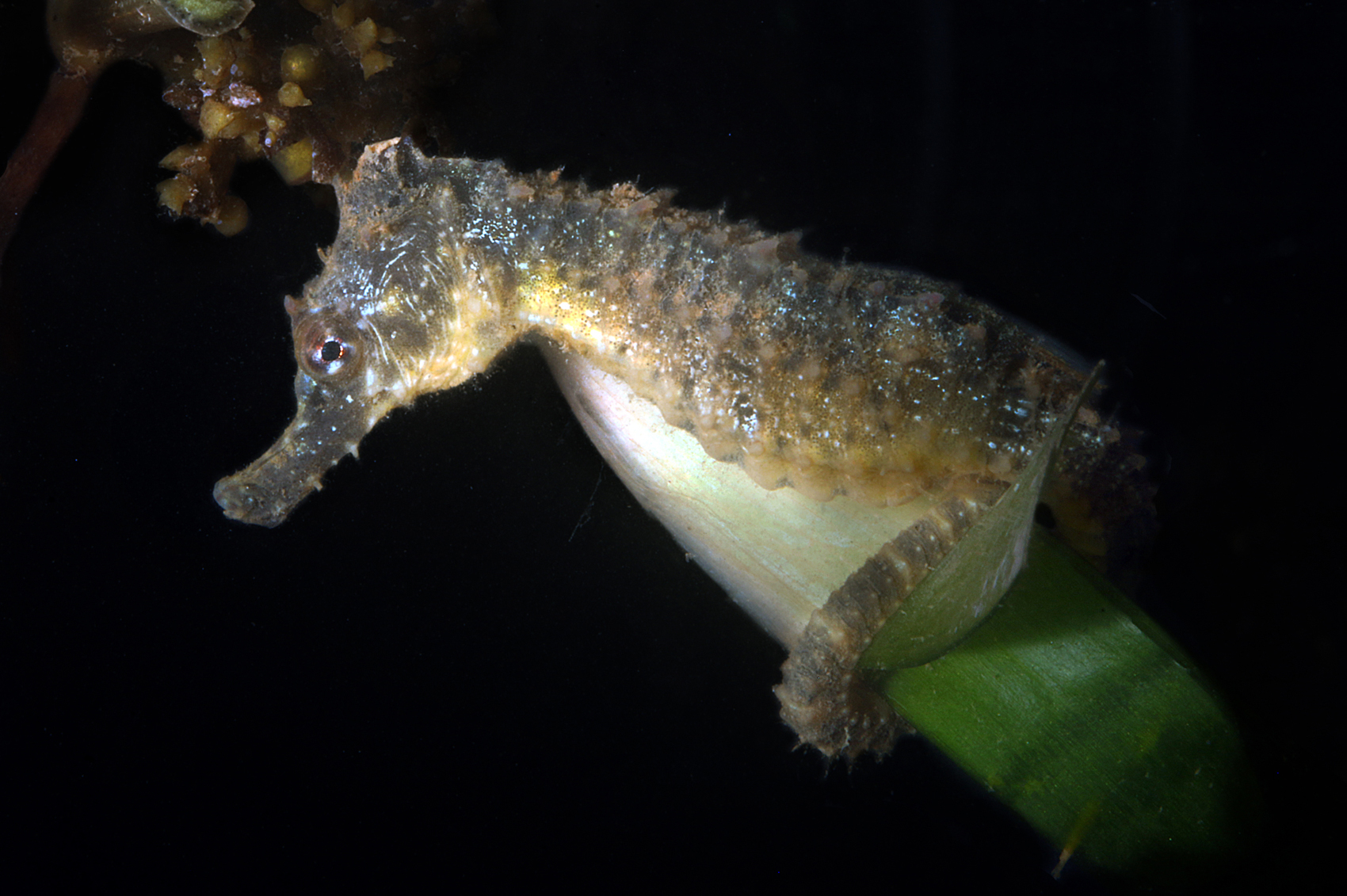Flatface Seahorse, Hippocampus planifrons Peters 1877

A Flatface Seahorse, Hippocampus planifrons, in Exmouth Gulf, Western Australia, June 2020. Source: Alex Hoschke / iNaturalist.org. License: CC By Attribution-NonCommercial
A seahorse with a relatively small head, a short and upturned snout, a flat face, a slender trunk, and a low coronet and spines. Females are overall greenish brown with a spotted snout, and dark blotching over the back of the trunk and tail.
Flatface Seahorse, Hippocampus planifrons Peters 1877
More Info
|
Distribution |
Endemic to Western Australia, from Dirk Hartog Island to Broome. Inhabits tidepools, macroalgal and rubble reefs in shallow bays from the intertidal to a depth of about 20 m. |
|
Features |
Dorsal fin 23-24 (usually 23); Anal fin 4; Pectoral fin 18-19; trunk rings 11; tail rings 37-38; subdorsal rings 3-4 + 1. Head relatively small, snout short, about equal to postorbital length; nasal profile convex, rising upwards to angle of about 45° from snout; trunk slender, more than twice as long as its depth in adults. Spines and tubercles: Body ridges with small tubercles becoming smooth with age. Subdorsal spines 4/0,0,1,1 or 5/0,0,0,1,1; small outwards curving spine above eye; nape spine small, directed anterodorsally; shoulder ring spines small, uppermost spine low and directed outward next to gill-opening, central spine at level just below level of centre of pectoral-fin base, lowermost spine directed outward; small lateral head spine; small spine behind eye; body spines of small to moderate size along dorsal and lateral ridges, few enlarged, most prominently along dorsal-fin base. Coronet: Coronet slightly raised, 2 small anterior spines, 3 posterior spines of moderate size, central spine enlarged and recurved. Fins: Dorsal-fin origin variable in position, ranging from before, in front of, on, or behind 8th trunk ring. |
|
Size |
Height to 70 mm, but may grow to 120 mm. |
|
Colour |
In life - females overall greenish brown with dark blotching over dorsal region of trunk and tail; snout with dark lateral spots. In preservative - body mainly brown, snout with dark spots. |
|
Feeding |
Like most other seahorses, this species presumably feeds by sucking small crustaceans and other small prey items, including planktonic zooplankton, into its mouth. |
|
Biology |
The female transfer her eggs into an elaborate enclosed pouch under the abdomen of the male. The male not only fertilizes the eggs inside the pouch and provides physical protection for the developing embryos, he also osmoregulates and aerates the embryos and may provide some nourishment until the offfspring are born. |
|
Fisheries |
Of no interest to fisheries, and not traded in the Asian Traditional Medicine market. |
|
Conservation |
Listed under Appendix II of the Convention on the International Trade in Endangered Species of Wild Flora and Fauna (CITES). As a result, the species is subject to the Convention, http://www.cites.org/. |
|
Remarks |
H. planifrons has been regarded by some authors as a synonym of H. trimaculatus. Specimens from the Northern Territory and Queensland which were previously misidentified as H. planifrons are the Lowcrown Seahorse, H. dahli. Some authors regard H. biocellatus to be a junior synonym of H. planifrons. |
|
Similar Species |
|
|
Etymology |
The specific name planifrons is from the Latin plan (= flat or level), and frons (= brow, forehead or forepart), in reference to the flat face of this species. |
|
Species Citation |
Hippocampus planifrons Peters 1877, Mber. K. Preuss. Akad. Wiss. Berl. 1876: 851 Type locality: "Naturalists Channel", NW. Australia, 10 fathoms. |
|
Author |
Bray, D.J. 2020 |
|
Resources |
Flatface Seahorse, Hippocampus planifrons Peters 1877
References
Kuiter, R.H. 2000. Seahorses, Pipefishes and their Relatives. TMC Publishing, Chorleywood, UK, 240 pp.
Kuiter, R.H. 2001. Revision of the Australian Seahorse of the genus Hippocampus (Syngnathiformes: Syngnathidae) with descriptions of nine new species. Records of the Australian Museum 53: 293-340. PDF Open access
Kuiter, R.H. 2009. Seahorses and their relatives. Seaford, Australia : Aquatic Photographics pp. 331.0
Lourie, S.A., Pollom, R.A. & Foster, S.J. 2016. A global revision of the Seahorses Hippocampus Rafinesque 1810 (Actinopterygii: Syngnathiformes): Taxonomy and biogeography with recommendations for further research. Zootaxa 4146(1): 1–66. https://doi.org/10.11646/zootaxa.4146.1.1 (considered H. biocellatus to be junior synonym of H. planifrons)
Lourie, S.A., Vincent, A.C.J. & Hall, H.J. 1999. Seahorses: an identification guide to the world's species and their conservation. Project Seahorse. London, UK. (considered H. planifrons to be a questionable synonym of H. trimaculatus)
Paulus, T. 1999. Family Syngnathidae. pp. 2264-2276 in Carpenter, K.E. & Niem, T.H. (eds). The Living Marine Resources of the Western Central Pacific. FAO Species Identification Guide for Fisheries Purposes. Rome : FAO Vol. 4 pp. 2069-2790.
Peters, W. 1877. Übersicht der während der von 1874 bis 1876 unter der Commando des Hrn. Capitän z. S. Freiherrn von Schleinitz ausgeführten Reise S. M. S. Gazelle gesammelten und von der Kaiserlichen Admiralität der Königlichen Akademie der Wissenschaften übersandten Fische.Monatsberichte der Königlichen Preussischen Akademie der Wissenschaften zu Berlin 1876: 831-854. See ref at BHL
Pollom, R. 2017. Hippocampus planifrons. The IUCN Red List of Threatened Species 2017: e.T68527310A47728827. http://dx.doi.org/10.2305/IUCN.UK.2017-3.RLTS.T68527310A47728827.en. Downloaded on 21 June 2018.
Whitley, G.P. 1940. Illustrations of some Australian fishes. The Australian Zoologist 9(4): 397-428 figs 1-45 pls 30-31 (as Macleayina planifrons) See ref at BHL





